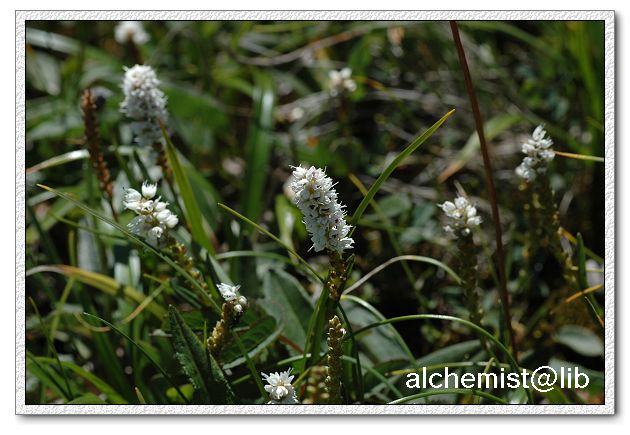珠芽拳参 Bistorta vivipara
- Scientific Name: Bistorta vivipara (L.) Delarbre
- Ref: Fl. Auvergne, ed. 2, 2:516. 1800
- Synonym: Polygonum viviparum L.
- English Common Name: alpine bistort
- Chinese Common Name: 珠芽拳参 zhūyá quánshēn, 珠芽蓼 zhūyá∙liǎo
- Japanese Common Name: ムカゴトラノオ [零余子虎の尾/珠芽虎の尾] mukagotoranoo
- Family: Polygonaceae
- Genus: Bistorta
- Distribution: Forest margins, grassy slopes, alpine steppes; 1200-5100 m. Gansu, Guizhou, Hebei, Heilongjiang, Henan, Hubei, Jilin, Liaoning, Nei Mongol, Ningxia, Qinghai, Shaanxi, Shanxi, Sichuan, Xinjiang, Xizang, Yunnan [Bhutan, India, Japan, Kazakhstan, Korea, Kyrgyzstan, Mongolia, Myanmar, Nepal, Russia, Sikkim, Tajikistan, Thailand; SW Asia, Europe, North America].
- Photo: 07/14/2008, Mt. Changbai, Jilin
Herbs perennial. Rhizomes black-brown, contorted, large, 1-2 cm in diam. Stems usually 2 or 3 from rhizome, erect, 15-60 cm tall, simple. Basal leaves long petiolate; leaf blade linear, ovate-lanceolate, or oblong, 3-10 × 0.2-3 cm, leathery, base rounded or cuneate, margin slightly involute, apex acute. Cauline leaves shortly petiolate or subsessile; leaf blade lanceolate smaller than basal ones; ocrea: lower part green, upper part brown, tubular, oblique, membranous, not ciliate. Inflorescence terminal, spicate, lower part with bulbils; bracts ovate, membranous. Perianth white or pinkish, 5-parted; tepals broadly elliptic, 2-3 mm. Stamens usually 8. Styles 3, connate at base. Achenes included in persistent perianth, dark brown, shiny, ovoid, trigonous, ca. 2 mm. Fl. May-Jul, fr. Jul-Sep. 2n = ca. 12*. (Flora of China)

07/14/2008, Mt. Changbai, Jilin
